A force for Arctic science: Dr. Jennifer Francis joins Woodwell Climate
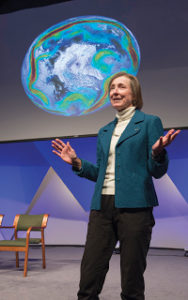
At the 2016 Arctic Matters Day, hosted by The National Academy of Sciences, Dr. Francis presented on the connection between weather and a melting Arctic
Before Dr. Jennifer Francis was a world-renowned atmospheric scientist. Before she pioneered the idea that a rapidly warming Arctic affects weather at lower latitudes. Before she became the go-to quote for journalists covering extreme weather in the age of climate change. Before she became the newest senior scientist at the Woodwell Climate Research Center (formerly Woods Hole Research Center).
Before any of that, Jen Francis sailed to the Arctic.
In the early 1980s, Francis took a break from her undergraduate studies and took five years to sail a 45-foot sloop around the world with her husband.
“As part of that we went up to the Arctic. This was pre-GPS. This was pre-cell phones. It was before you could get good weather information,” Francis said. “We went up to Svalbard (Norway), and the weather information we could find was basically useless.”
The couple sailed from Norway to Iceland, and then planned to continue on to Greenland and down the coast of North America to Massachusetts. When they left Iceland it was mid-September, with 12 hours of daily darkness.
“Immediately we started seeing icebergs, which was unexpected and bad,” Francis said. “Not small icebergs, the size of houses. It had been a really warm, early summer in eastern Greenland. So a lot more ice than normal had broken off of the glaciers. That first night was probably the scariest part of our entire trip.”
They were forced to retreat, turning back to Iceland and eventually re-routing directly south. The detour added 6,000 miles to their trip, but Francis was hooked by the idea of better understanding weather patterns.
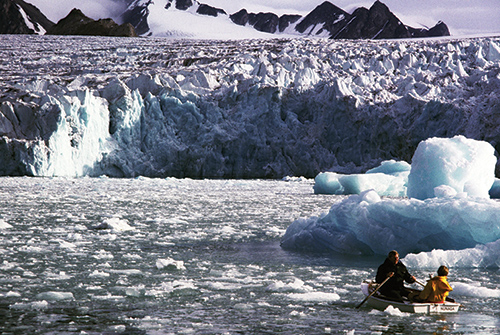
Dr. Francis and her husband in the 1980s, navigating through sea ice on the way to their boat.
Back on land, she returned to school at San Jose State University where she earned a bachelors degree in meteorology. She decided that she wanted to focus on research, not forecasting, and got her Ph.D. from the University of Washington.
“I’ve been studying the Arctic my entire career, really starting as an undergrad,” Francis said. “It goes back to when my husband and I sailed up the Arctic in 1984. I knew then what I wanted when I went back to school.”
Now, more than three decades later, her research is focused on unseasonably warm weather and the resulting impacts. The Arctic is warming twice as fast as the rest of the world, and Francis has zeroed in on the connection between that warming, and weather changes in mid-latitudes. The crux of her work is that a warmer Arctic disrupts the flow of air from lower latitudes toward the poles. That disruption, in turn, has disrupted and redirected the jet stream.
She joined Woodwell Climate Research Center from Rutgers University’s Institute of Marine and Coastal Sciences in September to continue this research.
“I feel like we are just scratching the surface of how a rapidly warming Arctic is affecting weather patterns at mid-latitudes. There is a lot more work to do,” Francis said. “That’s really where I plan to focus, with the ultimate goal of knowing what to expect in the future, in the next decade to four decades. That’s really the window where policymakers need to think about decisions they have to make. Decisions about infrastructure. Really expensive decisions that have to be made and they shouldn’t be made in a vacuum. They should be made with good information.”
Three years ago, Francis spoke at a Woodwell Climate public event. And in 2016, she discussed Arctic warming with a panel of Woodwell scientists on the main stage at the annual Arctic Circle conference in Reykjavik. But the news that she was joining the Woodwell Climate staff sent a buzz of excitement through the headquarters building.
“I’m absolutely thrilled to have Jen Francis at [Woodwell Climate],” said Woodwell Deputy Director Dr. Max Holmes. “I’ve greatly admired her for many years. In fact, if I had my choice of any scientist in the world to add to our staff, she’d be the one. She shows how changes in the Arctic are impacting extreme weather outside of the Arctic, including where most of us live.”
Francis’ research has received significant academic attention, but she has also broken out to a wider range of outlets.
“Not only does she do cutting-edge science, but she does a superb job of communicating her research to broad public audiences,” Holmes said.
When historically low temperatures struck the midwest of the United States earlier this year, Francis appeared on PBS’ News Hour to discuss the latest research on climate change and disruptions to the polar vortex, and was interviewed by the New York Times, the Associated Press, USA Today, the Chicago Tribune, and numerous other outlets. In 2018, she authored an op-ed in the Washington Post on the extreme weather phenomenon and was quoted in publications nationwide about record-breaking hurricanes. She has appeared on cable news and National Public Radio, and has spoke to countless audiences.
“There is the communications side that I spend a lot of my time doing, taking these complicated research results and weaving them into story,” Francis said. “I talk to media. With an event like Hurricane Michael or Hurricane Florence I probably talked to six media people every day. I do a lot of writing for more targeted journals. And I’ll talk to just about anybody. I see that as a really important aspect of my job. I didn’t plan on that. I kind of got thrown into it. But I really like it.”
by Connor Murphy –
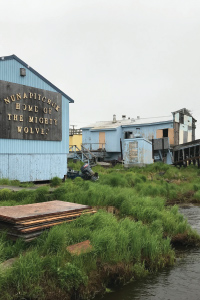
by Connor Murphy –
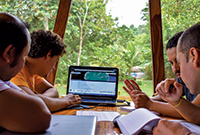 On a Monday morning, a group of indigenous leaders, scientists, and forest managers rose at dawn at a research station in Peru’s Andean cloud forest. Sun-splashed through the windows of a tall lecture hall, illuminating the ceiling’s long wooden beams. Inside, a translator worked with dozens of people to navigate scientific terms in three languages.
On a Monday morning, a group of indigenous leaders, scientists, and forest managers rose at dawn at a research station in Peru’s Andean cloud forest. Sun-splashed through the windows of a tall lecture hall, illuminating the ceiling’s long wooden beams. Inside, a translator worked with dozens of people to navigate scientific terms in three languages.
It was the first day of a workshop to discuss strategies to protect the Amazon.
The Amazon is the largest tropical forest in the world, storing 40 percent of all tropical forest carbon and accounting for 15 percent of global photosynthesis. It covers more than 1.7 billion acres, stretching across nine countries.
If the Amazon rainforest were a country, it would be the seventh largest in the world.
The carbon stored in this immense tropical forest is critical to the trajectory of climate change. The more carbon that remains locked up in trees, the less there is in the atmosphere. But deforestation and forest degradation (the death or removal of individual trees) are again on the rise. Exacerbating the issue, Brazil’s new president has signaled a lack of support for protected forest areas.
And while these human pressures increase, climate change impacts are taking a toll, with drought and wildfires ravaging areas of forest. While almost no fires occurred in indigenous reserves prior to 2006, wildfires are now seen every three to five years in drier regions.
 On the frontlines of this struggle are land managers, government officials, and indigenous leaders responsible for managing and protecting the forests.
On the frontlines of this struggle are land managers, government officials, and indigenous leaders responsible for managing and protecting the forests.
In the summer of 2018, Woods Hole Research Center scientists held four workshops to deliver the latest and best climate science to the people responsible for the future of the Amazon.
“Over the last decade, we’ve spent a lot of energy creating datasets on biomass and climate in the region. Too much of that information has stayed in the realm of scientific publications, and has not really reached managers in the region,” said WHRC scientist Dr. Marcia Macedo. “There are a lot of people on the ground working in this space—people who are hungry for information to help them adapt to climate change. We want to translate our science into accessible formats that can inform their day-to-day management and broader policy decisions.”
The workshops were supported by the Gordon and Betty Moore Foundation, and held in Colombia, Ecuador, Peru, and Brazil. All told, more than 125 attendees from at least 50 institutes took part in the weeklong trainings. The events were based around a new tool developed by WHRC—the Climate Source (amazonclimatesource.org)—a website that uses satellite imagery and climate data to provide detailed projections on climate change impacts like temperature trends, extreme weather events, dry season lengths, and precipitation. Clicking on a specific region brings up an easy-to-read toolbar, with options to look at historical data or projections over different future time periods.
“People who are managing forests often don’t have the time to dig into the scientific data, or read all the latest publications. The value of this data portal is that it condenses the latest science for the user in an accessible way,” Macedo said. “We can’t imagine all the potential applications for this kind of information.”
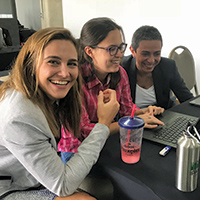 Attendees said that having access to climate data from a reputable and impartial scientific research organization was critical to getting it integrated into policies, regulations, and planning.
Attendees said that having access to climate data from a reputable and impartial scientific research organization was critical to getting it integrated into policies, regulations, and planning.
“When science is credible, legitimate, and relevant, then it can be delivered most effectively into policy,” said Julia Shimbo, a researcher at IPAM, WHRC’s longtime partner institution in Brazil.
“We need to be able to manage protected areas using scientific climate data,” said Carlos Mogollon, an ecological engineer who works in the Peruvian Amazon for the national government agency that manages protected areas. Mogollon attended the Peruvian workshop in June. “We only have the perception of the climate change that we see happening in the protected areas. The challenge is to link those changes to scientific data. From there, we need to identify adaptation measures.”
Macedo said that WHRC scientists want “to create a network of data savvy managers, and to translate [the data] in ways that can be passed on and taken up.” That network has already begun to develop, with connections forged during the workshops growing into online message groups and virtual collaboration. Within a month of attending the workshop, one Bolivian scientist was training other colleagues on how to use the Climate Source data.
WHRC scientists explained that the data were based on climate models from the U.N.’s Intergovernmental Panel on Climate Change.
“For future projections, we synthesized 25 global climate models from the IPCC,” said WHRC scientist Dr. Andrea Castanho. “The models don’t predict exactly the same future conditions, but they do show a trend.”
The ultimate goal, according to WHRC scientist Dr. Michael Coe, is a cadre of land managers who understand the climate data well enough to prepare for impacts, and to conserve critical areas of forest.
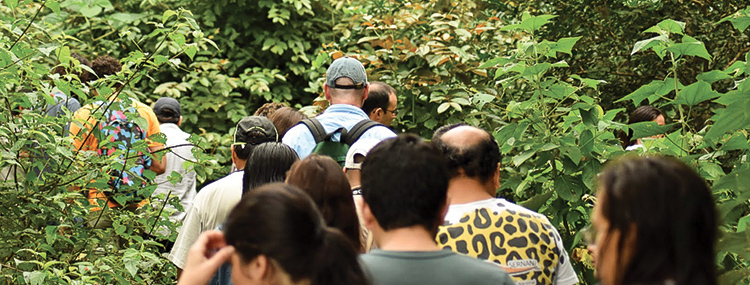
“We figure you are better off if you are informed. It’s been very hard for anyone who isn’t a scientist to ingest climate science data. You have to be very technical to be able to do that. So our goal is to take this technical stuff and make it very available,” Coe said. “We take complex information and make it accessible.”
He said that the team worked with end-users throughout the development, to ensure that the final product would be useful. Coe gave credit to IPAM for the philosophy that “you don’t try to change the user to understand the graph, you change the graph to fit the user.” As a result, he said, the workshop attendees threw themselves into the climate science.
“People have been very engaged. I think they come away with something new,” Coe said. “Already we’ve seen people go home from the last workshops and spread what they’ve learned to their colleagues. That’s exactly what we’d like to see.”



